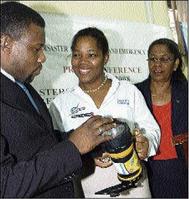Gareth Manning, Gleaner Writer
Director General of the Office of Disaster Preparedness and Emergency Management (ODPEM) Ronald Jackson (left) inspects a flashlight shown to him by brand manager, Dionne Morris (centre), for Rayvac Batteries at T. Geddes Grant Distributors Ltd. Looking on, during a press conference yesterday to launch Disaster Preparedness Month at the ODPEM's Camp Road office in central Kingston, is Director of the National Meteorological Service, Sylvia McGill. - Norman Grindley/Deputy Chief Photographer
Disaster management officials are facing a number of challenges going into the 2008 Atlantic hurricane season, which begins tomorrow.
There are 16 storms predicted for 2008, two to five of which are expected to become major hurricanes, but the Office of Disaster Preparedness and Emergency Management (ODPEM) says preparations for the upcoming season are not ideal.
Already this week, the first tropical storm, Alma, formed and subsequently weakened.
"Nationally, I think we are better than last year and those signs are always encouraging," ODPEM Director General Ronald Jackson told The Gleaner this week, ahead of a press briefing held at his Camp Road office in central Kingston yesterday.
"As it relates to resources and capacity, there is a lot of work that we still have to do in terms of building capacity in some of the critical areas such as search and rescue and swift water rescue."
A bit worried
But, more importantly, the ODPEM head was worried that there would not be enough resources in place to deal with the number of persons displaced if the country was hit by a major hurricane.
"When you look at the areas of high vulnerability and add up the numbers, the resource levels are not going to be in place to deal with the priority communities which are highly vulnerable as well as to deal with the secondary areas of concern."
He said that, given the number of people likely to be displaced after a major hurricane, emergency shelters would also need to be bolstered.
Partnership
"We've never had qualms about that area. I believe in signalling to the general public that we have to operate as a partnership to ensure success," Jackson said.
He noted that ODPEM was exploring other options to boost its resources, but it imagined that it would have to roll out resources to vulnerable communities first and hope for the best as it moved down the ranks.
Close to a year after Hurricane Dean struck, some communities have still not fully recovered. Old Harbour Bay in St Catherine and Portland Cottage and Rocky Point in Clarendon were the worst affected.
Unavailable resources
"I wouldn't say that we are satisfied (with the reconstruction in some communities) but I think part of it is the challenge of available resources, given the national situation ... and one of the things that we have to do is look at other mechanisms in terms of internal self insurance, like building on the National Disaster Fund," he said. The disaster fund has grown by another $50 million this year to $150 million, but that won't be enough to indemnify the billions hurricanes usually cost. Jamaica suffered approximately $22 billion in total damage from Hurricane Dean last year alone.
While the country is insured against hurricanes and earthquakes by the regional Caribbean Catas-trophe Risk Insurance Facility (CCRIF), Jackson thinks the National Disaster Fund ought to be grown to act as an alternative in case the island fails to qualify for benefits from the CCRIF plan as it did last year.
"We can grow it by getting inflows from the National Housing Trust which can be used to help those who are contributors to the trust, and inflows from the National Insurance Scheme can be used likewise," he said.
Regarding readiness for this hurricane season, Jackson also revealed that drain cleaning operations now underway are not adequate to cope with the anticipated flooding from heavy rainfall.
gareth.manning@gleanerjm.com

